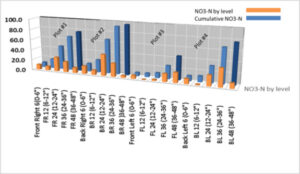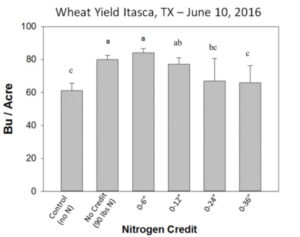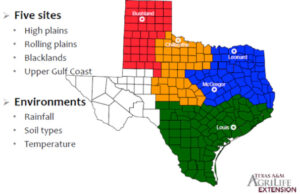2017 Annual Report for OS16-095
Deep Soil Profile Sampling of Nitrate for Residual Nitrogen Credit in Winter Wheat - Texas Blacklands
Summary
A study performed over the 2015/2016 wheat growing season showed that a producer could benefit from reducing nitrogen (N) fertilizer inputs based upon and deep profile soil test for residual nitrate (NO3) N. However, recovery of NO3-N was only 100% efficient to the 12” depth at this single site, contrasting with 24” recovery in warm season crops. Questions raised by the results prompted refinement of the treatment structure in year two to determine whether inefficiency of overall N uptake was due to poor recovery of NO3-N from the soil or due to losses of surface applied, top-dress fertilizer.
Objectives/Performance Targets
- Perform two studies in consecutive years on wheat recovery of residual N as measured by the deep profile soil test.
- Communicate results of studies to producers in outreach events to encourage adoption of this conservation measure to reduce N fertilizer inputs.
Accomplishments/Milestones
A cooperator study was initiated at Itasca, TX (Albert Sulak III; Hill Co.) in fall 2015 with the site laid out as a randomized complete block study design. Four replicate blocks arranged as quadrants within a larger square were randomized to contain 6 treatments of individual plots sized 10’ by 25’ with 5’ alleys in between the back of the plots and front of the next plot. Based on the performance of commonly-planted varieties across multiple years, we considered a representative yield goal to be 60 bushels grain per acre at this location. The six treatments were as follows:
Treatments:
- Control – no addition of N fertilizer; all other nutrients applied as per soil test recommendations (Texas A&M AgriLife Extension Soil, Water, and Forage Testing Laboratory).
- Credit for N measured to 6” (15 cm) – NO3-N to 6” subtracted from amount of N required to meet yield goal
- Credit for N measured to 12” (30 cm)
- Credit for N measured to 24” (61 cm)
- Credit for N measured to 36” (91 cm)
- No Credit – Full N fertilization to reach yield goal regardless of existing soil N (100 kg N / ha)
Site Management Details:
- Wheat Variety = WB Cedar
- Planting Date = 18 November 2015
- Fertilization = 22 kg N/ ha & 100 kg P2O5 / ha at Feekes growth stage 2 (Dec. 2, 2015)
- Topdress Fertilization = as treatments (minus initial N) above just prior to jointing (Feekes growth stage 5; Feb. 25, 2016)
- Machine Harvested = June 10, 2016
Year One Results:
Soil tests for deep profile residual N revealed some plot scale variability (Figure 1). Yield results showed significant differences (Figure 2). In previous studies in corn, cotton, and grain sorghum in the same region of the state, we found 100% recovery of N to 24” (61 cm) in > 95% of the sites investigated over a period of 5-8 years for each crop. The fact that recovery was not as efficient for this first year wheat study requires an explanation.
One possible reason for the outcome include the difference in seasonal growing conditions. A cool season crop such as wheat has a longer dormant period between planting in late fall/ early winter and the maximal growth phase which begins 3 months later. During this period, very little nitrogen is used by the plant and the NO3 may leach below the root zone or denitrify under heavy rainfall conditions. However, close inspection of the specific plots that yielded less under 24” and 36” credit treatments showed that plots 1 & 2 yielded similar bushels / acre as the zero credit treatment (full rate of N) while plots 3 & 4 produced yields similar to the control (no additional N). This pattern of yield variability followed the pattern of available, residual NO3-N in the soil tests for each plot to 36” (Figure 1).
This relationship led to the refinement of the study design to include more rates of applied fertilizer x credits to 24” (61 cm) at 5 sites in year two. Additional funding from the Texas Small Grains Advisory and Wheat Producer’s Boards were leveraged to complement the funding from SSARE in order to manage additional sites (Figure 3).

Figure 1. Soil test results (y axis = lbs / acre N) for study site at Itasca, TX. Samples acquired Oct 2015.

Figure 2. Yield results for study site in Itasca TX. Yields when crediting N to 12” (30 cm) not statistically different than applying full amount of N fertilizer without reduction.

Figure 3. Five sites included in Texas for year two of the On-Farm Project. Leonard and Louise sites managed by PI Mowrer and SSARE funding. Additional sites managed in cooperation with Dr. Clark Neely and funded by the Texas Wheat Producer’s Board.
Year One Outreach and Communication:
Results of the 2015/2016 study have been communicated at the ASA/CSA/SSSA annual meetings in Phoenix, AZ (Nov. 2016), and discussed directly with wheat producers at the Bell County Crops Conference (Building Incomes in Grains; Jan. 2017) and in other county or multi-county producer meetings:
Completed programs:
- Stiles Farm Foundation Field Days (Thrall, TX June 2016)
- Taylor Co. Wheat Conference (Abilene, TX Aug. 2016)
- Falls Co. Crops Committee (Rosebud, TX Oct. 2016)
- Hill Co. Producers Meeting and Field Days (Hillsboro, TX Nov. 2016)
- Texas Agriculture Industries Alliance Meeting (El Campo, TX Nov. 2016)
- Texas Plant Protection Conference (College Station, TX Dec. 2016)
- Fort Bend Co. Row Crops Conference (Rosenberg, TX Jan. 2017)
- Upper Gulf Coast Feed Grain and Cotton Conference (Wharton, TX Jan. 2017)
- Caldwell Producers’ CEU Program (Caldwell, TX Jan. 2017)
Upcoming programs:
- Abilene forage producers program (Abilene, TX Mar. 2017)
- Brazoria Co. Producers program (Angleton, TX Mar. 2017)
- Multi County Wheat tour (Millersview, TX May 2017)
- Taylor County Wheat Tour (Abilene, TX May 2017)
Year two study expansion:
Soil testing for residual nitrogen with Albert Sulak III revealed no residual nitrogen at his farm. We continued working with Mr. Sulak III on a project to evaluate the effectiveness of nitrogen fertilizer stabilizers in reducing N fertilizer losses in wheat. However, this study is not funded by SSARE and this On Farm project was forced to seek sites elsewhere with alternative cooperators to continue as described. Ronnie Lumpkin (Fannin Co.) and Travis Janak (Wharton Co.) agreed to participate. At approximately the same time, a collaborative effort with Texas A&M AgriLife small grains extension specialist Clark Neely received funding from the Texas Wheat Producer’s Board. Through aligning the study designs for residual nitrate recovery in wheat, a total of 5 sites were installed for the 2016/2017 season (Figure 3).
Year two treatment structure:
The expanded study was designed to answer questions regarding the differential efficiency of pre-existing soil NO3-N recovery efficiency with the use efficiency of applied fertilizer at top dress. Additional information gathered will allow AgriLife Extension specialists to keep current the recommended yield goal based N fertilizer rates for wheat in several important production regions. In this new study design, six rates of fertilizer application are compared against four depths of residual NO3-N crediting. Treatments within the original study design are conserved, with the exception of the 36” credit. However, soil tests were collected to 48” and data on all control plots can be evaluated for recovery to 3 and to 4 feet.
1. Control – no addition of N fertilizer
2a. 50% recommended rate N fertilizer
2b. 50% recommended rate less 6” credit
2c. 50% less 12” credit
2d. 50% rate less 24” credit
3a. 75% recommended rate N fertilizer
3b. 75% recommended rate less 6” credit
3c. 75% less 12” credit
3d. 75% rate less 24” credit
4a. 100% recommended rate N fertilizer
4b. 100% recommended rate less 6” credit
4c. 100% less 12” credit
4d. 100% rate less 24” credit
5a. 125% recommended rate N fertilizer
5b. 125% recommended rate less 6” credit
5c. 125% less 12” credit
5d. 125% rate less 24” credit
6a. 150% recommended rate N fertilizer
6b. 150% recommended rate less 6” credit
6c. 150% less 12” credit
6d. 150% rate less 24” credit
Each of the sites has now received top-dress fertilizer (warm year). The remaining work is to maintain the study sites, harvest, and measure yields and post-harvest soil samples. Beyond this, the expanded team will continue to communicate results in meetings and producer events, produce extension publications, and publish journal articles.
Impacts and Contributions/Outcomes
In cotton, corn and grain sorghum production across Texas, the following statistics were compiled for the years 2012-2013:
- 104,000 acres cotton participated in NO3-N credit program
- 129,000 acres corn and grain sorghum participated
- $23 per acre average savings in N fertilizer for cotton producers crediting residual NO3-N
- $31 per acre average savings for corn and grain sorghum producers
- N fertilizer applications reduced by > 9 million pounds over same two years – reducing likelihood of ground and surface water contamination and increasing economic viability of row crop production
- Increased statewide net returns to farmers of $12 million over same two years.
We expect to gather data from deep soil nitrate testing in wheat production to communicate similar outcomes from the studies funded by and inspired by this On Farm Project.
Collaborators:
Sulak Farms
9669 SH 171
Itasca, TX 76055
Program Specialist
Texas A&M AgriLife Extension
2474 TAMU
College Station, TX 77843-2474